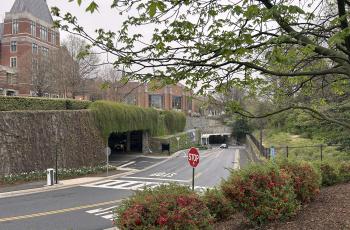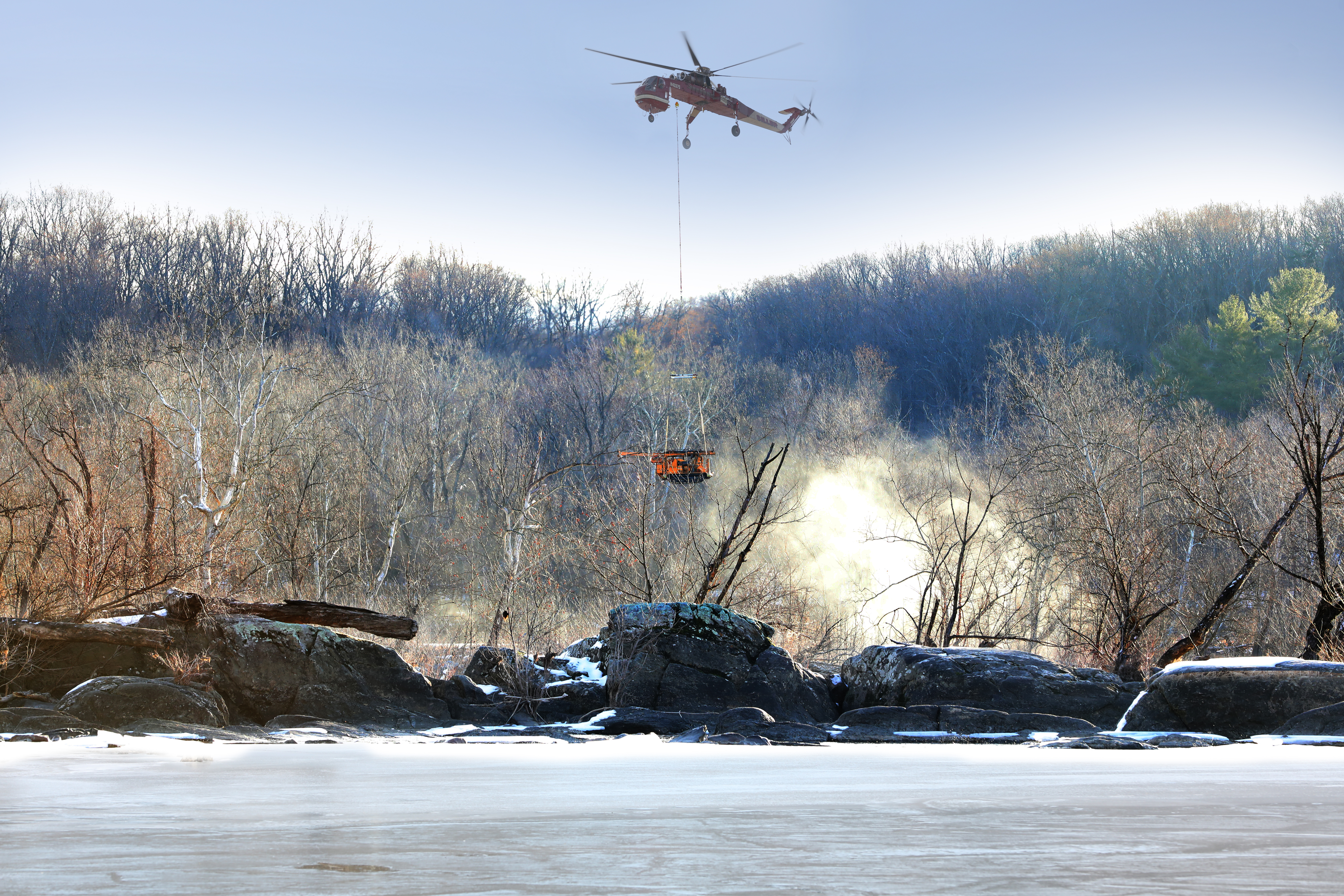DC Water issues Boil Water Advisories to protect public health when there is a water quality risk.
Should a loss in pressure occur, DC Water will issue a Boil Water Advisory for the impacted area until water quality testing can confirm the water is safe.
DC Water staff would sample and test the water while crews flush the distribution system with clean water to get rid of any potentially contaminated water.
An advisory would remain in effect until two rounds of sampling and testing confirm the water is safe.
A pressure change increases the potential for contaminants to enter the water system.
Although the chance of contamination is slim, we err on the side of caution and issue the advisory until we can confirm that water quality is not compromised.
Fill a pot or kettle with water.
Heat the water until bubbles come from the bottom of the pot to the top.
To kill germs, bring water to a full rolling boil for 1 minute.
Turn off the heat source and let the water cool.
Pour water into a clean container with a cover for storage.
Use boiled or bottled water to make coffee since your coffee maker does not boil the water.
Do not use ice from ice trays, ice dispensers, or ice makers.
Throw out all ice made with tap water.
Make new ice with boiled or bottled water.
Wash fruits and vegetables with cooled, boiled water or bottled water.
Bring water to a rolling boil for one minute before adding food to cook.
Use boiled water when preparing drinks, such as coffee, tea, and lemonade.
Wash food preparation surfaces with boiled water.
Dishwashers are safe to use if the water reaches a temperature of at least 160°F or if the dishwasher has a sanitizing cycle.
To wash dishes by hand:
Wash and rinse the dishes as normal using hot water.
In a separate basin, add 1 teaspoon of unscented household bleach for each gallon of warm water.
Soak the rinsed dishes in the water for at least 1 minute.
Let the dishes air dry completely.
Animals, including pets and service animals, can get some of the same diseases as people. It is a good idea to give them boiled water that has been cooled.
Most germs that infect people do not infect reptiles or fish. If your water system is using more chlorine or changing disinfection, be cautious about changing the water in your fish tank or aquarium. Contact your local pet store or veterinarian for more advice.
You can use tap water for household plants and gardens.
No. Do not use tap water to brush your teeth. Use boiled or bottled water.
Yes, it is safe to take a bath or shower, but be careful not to swallow any water. Use caution when bathing infants and young children. Consider giving them a sponge bath to reduce the chance of them swallowing water.
Run your cold water taps for 10 minutes if you did not use water during the advisory to replace water sitting in pipes with fresh water from the main. Water quality can decline when it sits for extended periods of time in pipes. If you used water consistently to flush the toilet, shower, or wash your hands, this action is precautionary, not necessary.
Discard food, beverages, and ice prepared with water that was not boiled during the advisory.
Yes, the advisory is not to consume the water. In the District of Columbia, the splash pad water is treated at the facility.
As always, if you experience unexpected illness, please consult your healthcare provider.
No for most filters.
The filter must meet NSF P231 (Microbiological Water Purifiers), NSF 58 (Reverse Osmosis), NSF 53 for cyst reduction or to effectively remove microbial contaminants.
For more information about different filter types see our DC Water page on water filters
Yes. Be sure to scrub your hands with soap and water (worm or cold) for 20 seconds and rinse them well under running water. It is important to dry hands completely with a towel or by letting them air dry.
Refer to your water management program. If your building does not have one, the main objective is to replace the water in the plumbing with fresh water. The faucets used for drinking or cooking are most important.
Start where the water enters the building and flush until fresh water from the water main is coming out (you might be able to detect a temperature change depending on time of year) and then flush an additional five minutes.
From the entry point, work your way through the building and upward one floor at a time.
Flush cold water until the water quality (ex., temperature) matches that of the flushed inlet, and then continue flushing for an additional five minutes.
Refer to the following resources for more information on how to develop a water management plan:
CDC Toolkit: Developing a Water Management Program to Reduce Legionella Growth and Spread in Buildings
EPA: Maintaining or Restoring Water Quality in Buildings with Low or No Use
Do not use water from any appliance connected to your water line, such as ice and water from a refrigerator.
To reduce the risk of contamination, ensure each water connection to the potable water supply and plumbing fixture has the appropriate air gap or backflow preventer in accordance with DC Plumbing Code. The following steps can be used to identify water use systems, plumbing fixtures, and backflows preventors.
Identify and inventory the following water use systems or fixtures:
System: Boiler, chiller, irrigation, cooling tower, fire sprinkler, pool, chemical dispenser, and any other water storage or use system.
Plumbing fixtures: mop and lab sink
2. Determine if the building has the appropriate backflow prevention assemblies or devices for each system or fixture per DC Plumbing Code. If there are backflow prevention assemblies, check to see if they are tagged indicating they were inspected within one year.
If you are unsure, contact a DC Licensed Plumber or DC Water (bpa@dcwater.com ) to conduct a survey to identify your potable water connections, fixtures, and backflow preventers.
More information on backflow preventers is available at Compliance Program | DC Water
3. Educate tenants about proper use and storage of hoses that connect to faucets.
Consider the risk of contaminants that could enter your plumbing (possible hose connections to janitor sinks or bathtubs) and add or revise flushing steps in your water management plan to address those risks. Also consider your occupants that have weaker immune systems (seniors, infants, etc. ) and ensuring flushing instructions highlight their faucets or needs.
Review the instruction manuals to determine if your touchless items have automatic flushing capabilities.
If your facility is not a healthcare or other sensitive population facility (for example, skilled nursing facilities, assisted living residents), then you might consider focusing on manually operated faucets since the use of faucets for handwashing was not restricted during the boil water advisory.
After the building has been flushed, check the flow rate of filtered water station.
If the flow is below normal, then replace the filter and post a sign to not use until the filter has been replaced.
Flushing the bottle-filling station is not necessary.
Cooled drinking water fountains should be flushed to replace the chilled water because the water could have entered the chiller during the event.
Yes, the advisory is not to consume the water. The pool water is further treated with chlorine to kill microorganisms introduced by people and children swimming in the pool.
DC Water Customer Service: 202-354-3600
Water Quality: 202-612-3440
DC Water 24-Hour Command Center: 202-612-3400
www.dcwater.com/emergencies
Additional Resources
Personal Water Use : CDC provides guidance on the amount of water needed for good health, as well as its preparation and storage in preparation for and during an emergency. Click here to access the CDC guidance
Hygiene and Sanitation : CDC provides guidance on alternative hygienic practices when water is not available or is contaminated.
EPA Safe Drinking Water Hotline: 1-800-426-4791
Consumer Information: EPA provides information and guidance about drinking water quality, emergencies, contaminants, public health issues, and treatment and storage.
Sí, es recomendable darles agua hervida o embotellada.
La mayoría de los gérmenes que infectan a las personas no afectan a peces o reptiles. Consulte con un experto en mascotas para más información.
DC Water emite Avisos de Hervir el Agua para proteger la salud pública cuando este en risgo para la calidad del agua.
Sí, puede usar agua del grifo para las plantas.
Un cambio en la presión aumenta la posibilidad de que contaminantes ingresen al sistema de agua.
No, use agua hervida o embotellada en su lugar.
Llene una olla o tetera con agua. Hierva el agua durante 1 minuto. Deje que el agua se enfríe antes de usarla.
Sí, pero evite tragar el agua. Tenga precaución al bañar a los bebés.
Use agua hervida o embotellada para preparar el café.
Abra los grifos de agua fría durante 10 minutos para limpiar las tuberías.
No use el hielo de bandejas, dispensadores o máquinas. Deseche el hielo hecho con agua del grifo.
Sí, los parques de agua son seguros ya que no implican el consumo de agua.
Lave las frutas y verduras con agua hervida fria o agua embotellada. Use agua hervida para la preparación de los alimentos.
Si experimenta síntomas, consulte a un profesional de la salud.
Use fórmula lista para usar si es posible. Si usa fórmula en polvo, prepárela con agua hervida o embotellada.
No, a menos que el filtro cumpla con estándares de seguridad específicos.
Los lavavajillas son seguros si alcanzan al menos 160°F. De lo contrario, lave los platos a mano con una solución de lejía.
Sí, lávese las manos con jabón y agua corriente durante 20 segundos.
La mayoría de las personas no se enfermarán. Los síntomas pueden incluir náuseas, diarrea y calambres.
Hervir el agua no elimina el plomo. Use un filtro certificado para la eliminación de plomo


